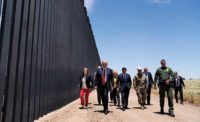It’s clear now that an organized plan for trade can never be expected to emerge from the Trump administration’s deal-oriented style. For business people wary of risks—and hoping to make some reliable estimates about future material sourcing—uncertainty about trade and tariffs has been a gnawing concern.
This month it reached a zenith as both Europe and Japan warned of retaliation against tariffs, NAFTA renegotiations stalled and the North Korean nuclear disarmament initiative complicated U.S.-China talks.
The storm has been coming for a long time.
Beginning with the 2016 election campaign, President Trump and his staff have said they will seek to promote U.S. manufacturing by breaking trade pacts and imposing tariffs.
What wasn’t said was how many economic eggs would be crushed in the name of promoting U.S. manufacturing and what that could do to prices. Nor was it said that exiting trade pacts such as the Trans-Pacific Partnership and renegotiating the North American Free Trade Agreement could upset international relations.
Perhaps what comes from Trump’s international trade swirl is a stronger America, but if this is economic nationalism, there must be a more organized way to practice it.
Back in March, when President Trump first unveiled his tariff plan, the European Union began preparing punitive counter-tariffs of 25% on $3.5 billion worth of U.S. goods produced by companies or facilities in areas represented by Republicans in Congress.
Japan, another historic U.S. ally, says it is preparing retaliatory measures, too; along with South Korea and Turkey, it is among the biggest exporters of steel products to the U.S.
All of this has made contractors that use steel and other affected materials and products increasingly edgy. With good reason.
There’s a better-than-even chance that Trump’s policies will create more problems than they solve.
William Hauk, associate professor of economics at the University of South Carolina, wrote that Trump’s initial proposal for a 25% tariff on finished steel and aluminum won’t resolve the persistent U.S. trade deficit and more likely will hurt both consumers and business.
Other aspects of international trade worry us more than dumping and unfair price competition. The burdens of intellectual property theft, as well as computer system hacks and the cost of protecting against them, weigh more heavily on U.S. businesses than does the decline of manufacturing.
China has been a particularly egregious thief when it comes to U.S. technology, and we would prefer more emphasis on that aspect of our commercial relations.
Beyond international trade, runaway medical costs pose more of a long-term economic threat to the financial health of U.S. workers and employers because of how health care drains huge sums from the national pocket.
Perhaps what comes from Trump’s international trade swirl will be a stronger America—but if this is economic nationalism, there must be a more organized way to practice it.




Post a comment to this article
Report Abusive Comment